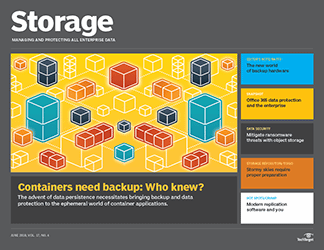PRO+ Premium Content/Storage
Access your Pro+ Content below.
Container backup follows data persistence to these ephemeral apps

This article is part of the Storage issue of June 2018, Vol. 17, No. 4
The container revolution was expected to herald a world of ephemeral container applications deployed and running across both public and private clouds. But the reality of enterprise data management is application data must be more persistent than the lifetime of a single container. As a result, vendors have added data persistence to container infrastructures, and that means container backup is now needed to protect container data like all other enterprise data. Protecting container data has its own set of requirements and processes. This article explores how container backup is being done and what vendors are setting the standards for backing up containers. The need for persistence As containers have grown in popularity over the last four years, it has become clear that completely transient application execution isn't compatible with the enterprise -- at least not in the way IT is usually delivered. Even the 12-factor methodology for application development states that although applications should be stateless (factor six) and ...
Features in this issue
-
Container backup follows data persistence to these ephemeral apps
The advent of data persistence in containers necessitates having data backup in containers. Here's how this is being done and which vendors are leading the way.
-
Office 365 data protection, the enterprise and you
Gain a better understanding of Microsoft Office 365 security and storage management features and how the popular cloud-based productivity and collaboration suite really works.
Columns in this issue
-
What's new with data protection systems? Everything
The next backup hardware you purchase will likely come with integrated backup software. That changes the buying dynamic and complicates the decision-making process.
-
Disaster avoidance requirements ensure business continuity
Include disaster recovery and avoidance requirements as design goals when creating storage and production environments to ensure business continuity during weather events.
